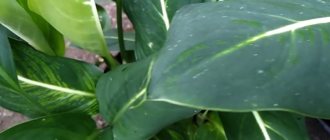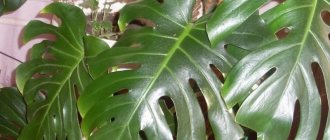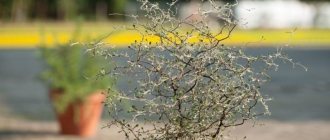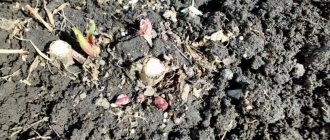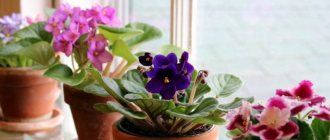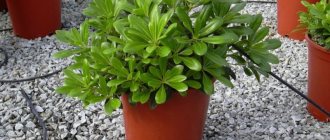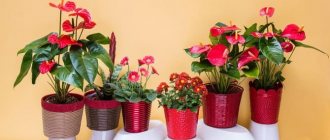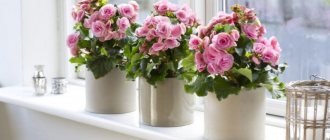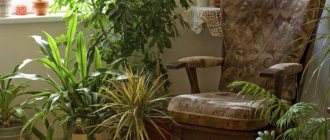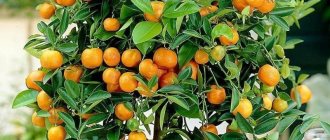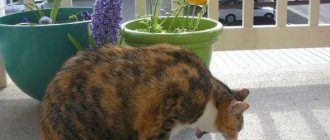Alocasia
In the natural conditions of the tropics, alocasia reaches gigantic sizes.
Alocasia (Alocasia) - Arum, Elephant's ear, an evergreen plant, hardy and fast growing in indoor conditions, native to the islands of the Indian and Pacific oceans.
At home, they mainly grow Alocasia macrorrhiza and Alocasia sanderiana, from the island of Ceylon - they grow quickly, form 4-5 large arrow-shaped leaves, bright green, on long succulent petioles. Alocasia juice is poisonous.
Alocasia in a tropical garden. Photo: Online Plant Guide
Rules of care and reproduction
- Alocasia is propagated vegetatively - by suckers, eyes, cut out with part of the pulp surrounding the eye. Alocasia offspring quickly take root in warm greenhouses.
- Alocasia can be propagated by seeds, but this is a troublesome process that does not guarantee results.
Alocasia seeds are obtained from berries. Photo: Plantgasm - Alocasia requires fertile soil consisting of humus, peat and turf (2:2:1) soil.
- Alocasia is kept at a temperature of +21 °C in the summer, with plenty of watering. The temperature in winter is not lower than +17 °C.
- In cloudy and rainy weather, drops of moisture are released at the ends of alocasia leaves.
Aroid plants: what are they?
Most plants of the araceae family are distinguished by the almost complete absence of true stems, whose functions are performed by modified rhizomes.
The only exceptions are vines, which, thanks to their tenacious aerial roots, easily climb vertical surfaces and colonize larger plants. It is interesting that such aerial roots, as in one of the varieties of epipremnum, not only help to support long, heavy shoots, but also nourish the plant, absorbing atmospheric moisture, and, if possible, taking root.
Therefore, when growing indoor aroid plants, they are under no circumstances removed, but, on the contrary, are used for feeding and maintaining the viability of long shoots.
The leaves of wild and indoor aroid plants are formed alternately. Moreover, in most species there is a pronounced petiole, and the leaf blades are striking in the variety of sizes, colors and shapes, like the indoor aroid plant called caladium, which has earned worldwide recognition and is shown in the photo. In addition to uniformly colored whole leaves, aroids can have intricately dissected, corrugated, variegated and unusually structured leaf blades.
It is thanks to such diversity and brightness that representatives of the family have shown interest as indoor and ornamental plants.
As for flowering, unlike the foliage, which is striking in its bizarre forms, there is no variety here. All aroid plants, whether indoor or wild-growing species, form a spadix-shaped inflorescence consisting of very densely arranged small flowers. At the same time, the line between male and female flowers is clearly visible on the spadix. However, in some species the flowers are bisexual. Although the structure of the inflorescences is common, their appearance and size can vary significantly, and most of them often give the impression of a large single flower, misleading both lovers of house plants and even insects that pollinate such inflorescences.
The decorative appearance and resemblance to a flower is given to the inflorescence by the perianth, which, depending on the type and variety of the plant, has different colors, shapes and sizes. Often the flowering is extremely surprising. And people who are not dedicated to the particularities of aroid plants ask: “What is this?” In fact, this is not an exotic orchid, or a skillful creation of a jeweler, but an anaphyllum inflorescence from India.
This giant inflorescence, included in the Book of Records, belongs to the giant amorphophallus. The size of the spadix, which unites up to five thousand flowers, in this case reaches 2–3 meters and protrudes high beyond the purple-green perianth.
There are significantly fewer flowers in the pistia inflorescence, only 5–9, and the dimensions here do not exceed 10 mm. Almost the same inconspicuous inflorescence is produced by another type of aroid plant - ambrosina.
In most species of naturally occurring and indoor aroid plants, the perianth partially or completely hides the spadix, performing a protective function and, at the same time, attracting the attention of pollinating insects to the inflorescence.
At the same time, evolution has gone so far that plants have appeared with trap blankets that make it possible to keep insects near female flowers until the pollination process is successfully completed.
The peculiar deception of insects is not limited to the special shape of the bedspread or its bright colors, like that of anthurium, an aroid houseplant, whose name and photo are well known to gardeners.
Some plants in the extended family emit an attractive aroma. An example of this is calla lilies, beloved by many.
But there are plants that attract a specific group of pollinators – flies. Therefore, these species have to resort to completely unexpected methods and measures. A rare feature of aroids is the ability to increase the temperature of the cob to 30–45 °C, so that volatile aromatic substances begin to actively evaporate from the heated surface of the flowers, spreading a strong smell of carrion throughout the area for several hours.
This technique is used not only by the already mentioned titanic amorphophallus, but also by Symplocarpus foetidus, Helicodiceros muscivorus and Sauromatum venosum, the flowering of which is shown in the photo. It is interesting that, despite the smell, this aroid plant is an indoor plant that is popular among lovers of exotic species.
At the same time, it is important for gardeners interested in this family to remember that aroid houseplants are poisonous. All parts of the plant, from tubers, rhizomes and stems, to leaves and inflorescences, contain calcium oxalate, which has a sharp irritating effect on the skin and mucous membranes.
In different types, the concentration of this substance may differ, but when caring for aroid houseplants, as in the photo, accompanied by direct contact, it is better to use gloves, and wash your hands after completing the work.
Home care
The diversity of aroids necessitates the creation of different conditions for their cultivation. But there are also general rules.
| Criteria | Description |
| Lighting | Most representatives of the aroid family prefer diffused lighting. Plants with variegated leaves need more light than those with green leaves. When the midday sun hits the leaves, brown spots form - burns. Lack of light causes the leaf blades to become small and the stems to become very elongated. In this case, it is recommended to use additional lighting with a phytolamp. |
| Temperature | During the summer period, the most suitable temperature is within 22-26°. With the onset of the autumn-winter period, the temperature drops to 19°. Aroids do not tolerate drafts well and can die from them. |
| Humidity | Most plants need high humidity. To do this, gardeners spray or wipe the leaf blades. It would not be a bad idea to place a container with wet expanded clay near the pot with the plant. |
| Watering | Aroids need good watering. Stagnation of water in the soil should be prevented. To do this, it is necessary to equip an effective drainage system using a layer of expanded clay or small pebbles. For irrigation, it is necessary to use water whose temperature is 3-4° higher than the air temperature in the room. With the onset of the dormant period, the frequency of watering decreases and is carried out as the soil dries a few centimeters. |
| Priming | For growing aroids, it is recommended to use loose and acidic soil. You can prepare soil for aroids yourself. To do this, peat, sand, leaf and coniferous soil are mixed. Experienced gardeners recommend adding small stones to the soil mixture. |
| Fertilizers | From the beginning of spring to the beginning of autumn, aroids need additional feeding. To do this, it is recommended to use fertilizers that contain components such as nitrogen, phosphorus, and potassium. Aroids respond well to foliar fertilizers. |
| Rest period | Comes from September to March. At this time, subcortexing is not performed, and the frequency of watering is reduced to once every 30 days. |
| Reproduction | Most representatives of this group reproduce by vegetative method (stem leaf cuttings). The possibility of propagation by dividing the bush cannot be ruled out. |
| Transfer | It is carried out mainly at the beginning of the growing season. It is recommended to choose shallow pots to prevent active growth of the root system. After installing the drainage system, the plant is placed in the middle of the pot and carefully covered with substrate. After this, the soil needs to be watered well. |
FEATURES OF CONTENT AND CARE OF AROIDS
By placing plants of the Araceae family on or near windows, shade your pets in the summer. The exception is for specimens standing on the north and north-east windows.
Plants in pots placed on heated floors require frequent watering and high drainage. You need to make sure that the roots do not dry out.
Large aroids are replanted in the spring, usually once every three years. If you plan to use the same pot, renew at least a third of the substrate.
Living suspended ceiling
When decorating a ceiling (or wall), you can stretch a frame of thin wire on it, along which you can string scindapsus or epipremnums, which are unpretentious to lighting and resistant to other adversities. Pots with plants are hung on the walls close to the ceiling. It is better to choose flat and elongated ones so that they do not catch the eye.
While planting abutilon seedlings, I noticed an unfamiliar sprout. I left it in a pot, it grew slowly. We determined it was spathiphyllum, but we don’t know which one. The grown one was replanted in universal soil. I noticed that the plant drops its tender leaves in the sun, but loves watering and showering. What kind of stranger has come to me, and what is necessary for his growth and development?
Tatiana PASHINSKAYA, Kharkov
I assume that you have a seedling of one of the species of the genus Spathiphyllum (Spathiphyllum) of the Araceae family, but it is difficult to determine which one from this photo. The seeds could have come from an old pot in which the plant bloomed and bear fruit, or from a greenhouse where soil mixtures are made (sometimes the manufacturer uses part of the soil from old greenhouses). The plant can only be accurately identified after it blooms.
SOUTH WINDOW IS NOT FOR HIM
It is not surprising that at first the seedling grew slowly, since spathiphyllums do not like spacious pots. Transplant the plant into a slightly larger container only when the roots protrude from the drainage hole.
In direct sun, spathiphyllums develop poorly, turn yellow, and dry out, which is why the seedling drops its tender leaves. This tropical plant in nature prefers to grow along the banks of streams. A dry southern window with scorching sun is not suitable for him, in the northern window it can be until flowering, and for an adult it will be better on a windowsill with an eastern or western orientation.
WATER LOVER
A love of water treatments is typical for spathi-phyllums, so it is advisable to give them a shower even in dim lighting. However, avoid stagnation of water in the pan and constant waterlogging. Water after the top layer of soil dries. If a white coating forms on the surface of the substrate, add 1-3 drops of lemon juice when watering.
As daylight hours decrease and the weather gets colder, it is necessary to reduce watering, and during the heating season, spray the plant more often. For the winter you can put it on a south window. Start feeding in March.
Photos and names of indoor aroid plants
Thanks to their spectacular appearance, many varieties of aroids are indoor plants that are loved by a multi-million army of amateur gardeners.
Among the many photos and names of indoor plants of the Araceae family, connoisseurs will certainly note the anthurium with glossy dense bracts in all shades of purple, scarlet, pink, and now also white.
The sincere love of flower growers is enjoyed by a variety of varieties of spathiphyllums, differing in the size of the plants themselves and graceful white inflorescences.
Monsteras, philodrendrones and large types of alocasia attract attention with extremely unusual foliage, however, to grow such crops, the gardener will have to choose a fairly spacious room, because large specimens can show their true beauty. But small alocasias are quite appropriate both in a residential interior and in a public building.
Aglaonema does not have carved foliage and does not stand out for its bright blooms, but the colors of its heart-shaped foliage will be the envy of any artist’s palette.
The same can be said about the leaves of such an indoor aroid plant as caladium.
In addition to multi-meter giants and plants suitable for growing in indoor pots, the family also contains real dwarfs. For example, pistia is a plant in demand by aquarium enthusiasts, with a rosette in diameter not exceeding 10–15 cm.
Syngonium is also a popular indoor plant. This is a fast-growing climbing plant from the araceae family, forming well-leafed shoots. Syngonium is interesting for its graceful shape of foliage and its variegated color, which changes as the plant develops.
Speaking about the family, one cannot help but recall Dieffenbachia, which has become a classic potted plant and has not left the collections of gardeners for many years. The appearance of variegated varieties, as in the photo, and simple care for indoor aroid plants help maintain popularity.
Raphidophora, with medium-sized expressive foliage and long shoots capable of climbing almost vertical bare walls, is not yet well known to gardeners.
Most species are intended and actively used in indoor floriculture, represented by many varieties and hybrids. But with such a wide variety, aroids in nature live in similar conditions, so caring for them consists of similar measures.
What you need to know about aroids?
Aroids are the largest family of monocots, which includes more than 100 plant genera and about 2000 species. In their natural environment, they are found in tropical and subtropical climates, but some also grow in the temperate zone. This family has various representatives: herbaceous plants, epiphytes, bushy plants, lianas.
Many have tubers and rhizomes that provide nutrition. When growing, pay attention to the fact that all representatives of this group tolerate drought better than flooding. Excess moisture is detrimental to many aroids. If it is deficient, the plant receives nutrition and moisture from the root system; naturally, this does not have the best effect on the condition of the plant.
Another feature of aroids is their aerial roots. They are necessary for attachment to a support in natural habitats. They can be found on the stem of epipremnum, monstera or certain types of syngonium. Aerial roots cannot be removed; on the contrary, such plants require vertical support for good growth. The vine itself should not grow downward, this will lead to a deterioration in its appearance.
The leaves of aroid plants require special consideration - here nature has done its best and painted them in various shades of yellow, green, red and orange. All these colors can be present simultaneously on one sheet; this feature cannot leave the gardener indifferent. Not everything has been said about leaves. Adult philodendrons and monsteras have their own peculiarity - their leaves become perforated or split spontaneously as they reach maturity.
Attention! Not all plants of the araceae family grow year-round. A striking representative, namely caladium, grows from late December to early autumn; the rest of the time the tuber rests.
Now let's look at the flowering features of this family. In all indoor plants, flowering is presented in the form of a cob, but these are not flowers, but modified leaves (spreads). The cover itself is necessary for the plant to protect the inflorescence and ripening of seeds in unfavorable living conditions. The inflorescences emit a smell (not always pleasant), which attracts pollinators in the form of insects.
Caring for decorative foliage plants
@ thatpichai stock.adobe.com The plant needs a small pot
The basic principles of caring for decorative deciduous representatives of the aroid family are simple:
- Watering. Produce as the upper earthen clod dries. The root system must constantly receive moisture, but the liquid should not stagnate in the flowerpot, so you need to arrange good drainage.
- Air humidity. This indicator must be maintained at the highest possible level, because the plants come from the tropics. The dry air of modern apartments is not suitable for them; the leaves become dull and thin, and lose their shine.
- Temperature conditions. During the period of active growth, plants require high temperatures; it is optimal to maintain it at 23-25 degrees. During the rest period, a decrease to 18 degrees is permissible.
- Feeding. During the first few months after transplantation, fertilizing is not required, because the specialized soil for aroid plants contains all the necessary mineral compounds that support the growth and development of the plant. As the soil becomes depleted, fertilizers with a high content of potassium and nitrogen are applied. These components affect the color of the leaves, making it more saturated. Aroids like not only root nutrition, but also leaf nutrition. Such fertilizers are often sold in aerosol bottles.
- Trimming. All plants growing in the form of a vine require pruning or formation on a support. Otherwise, the bushes will look “bald” due to large gaps between the leaf petioles.
- Transfer. Young plants are replanted several times a year, as the root system fills the pot. Adult plants - once a year, preferably in spring.
- Reproduction. Lianas are best propagated by cuttings, and both the top and intermediate material can be used to ensure this method. The lash is divided into segments up to 10 cm long and rooted in perlite, peat, or simply placed in water to grow roots. Rosette plants of the aglonema type themselves produce children. Reproduction is possible regardless of the season, but it is better to carry out the procedure in the spring, so the loss of planting material will be minimal.
- Treatment against diseases and pests. It is not carried out as planned; drugs are used when lesions are identified.
@ Lijuan Guo stock.adobe.com The plant forms into a vine
Features of care in winter
The main enemy of aroids in winter is the radiators of the centralized heating system. Their work not only increases the temperature in the room, but also significantly reduces the humidity level. If possible, plants should be placed at a distant distance from them. If this is not possible, you need to place expanded clay in one layer in the tray with the plant and pour water so that it covers the stones. Place a flowerpot on top. Spraying is carried out 2-3 times a day.
Fertilizing should not be carried out in winter; the plant should rest. Provide the aroids with plenty of sunlight, otherwise the stems will stretch and be unattractive.
Summer care
@ Lijuan Guo stock.adobe.com Syngonium variety "Pixie"
In summer, it is better to place plants on an east or west window, making sure to provide shading during the midday hours. The best option is to install a stand for flowerpots near a window. This way the plant will receive maximum light, but its leaves will not be burned by the sun's rays.
It is better to provide watering once every 2 days, provided that the soil dries out normally. To check this, use a long splinter (wooden stick). She needs to pierce the soil 4-5 cm. If it is dry, watering can be done.
Do not spray a plant that is on a sunny windowsill. This will inevitably lead to burns on the beautiful leaves of aroid plants. In this case, spraying should be carried out in the early morning and evening, after the sun has set. During the day, if it is very hot, you can humidify the air around the plant, thereby improving the microclimate.
Plants of the araceae family
Araceae, which are also called arumaceae, are flowering monocotyledons. Their family includes more than a hundred genera and about three thousand species. Most aroid plants are distributed in tropical and subtropical regions. There the conditions are most suitable for them, and some specimens sometimes reach incredible sizes.
Representatives of this large family also live in colder and harsher conditions. They can be found in the temperate and sometimes in the subarctic zone. However, in cool regions there are much fewer of them, because aroids gravitate towards moisture and warmth.
Plants amaze with their diversity. Among them there are many species of bizarre shapes, which are complemented by the unusual color of leaves and flowers. All of them are terrestrial and aquatic herbs, shrubs, vines and epiphytes. The latter are notable for the fact that they do not live independently, but settle on various plant forms. At the same time, epiphytes are not considered parasites; they use other organisms exclusively as support, feeding independently of them.
There are also marsh plants in the aroid rows. So, all duckweeds belong to them. They have very simplified roots and leaves, and live on the surface of ponds, swamps, lakes and small bodies of standing water. In a favorable period, they can completely cover their “water house”.
Application of arum
Despite the toxicity and possible unpleasant aroma, people did not abandon aroids and found areas where they could be used. Due to their unusual appearance and relative unpretentiousness, they have become popular ornamental plants. Due to the content of useful substances, they are used in medicine and cooking.
Aroid plants called taro, large-rooted alocasia, monstera deliciosa, and arrow-shaped xanthosoma can be eaten. But, as a rule, they are not prepared completely, but only individual parts - shoots, berries or leaves.
In folk medicine, calamus and its roots are used to obtain essential oils and treat intestinal and stomach diseases. Aronica treats inflammation of the mucous membranes and respiratory tract, relieves measles, scarlet fever and a simple runny nose. Ointments and tinctures are made from Monstera deliciosa to help with rheumatism and joint pain. Its fruits, which have a banana-pineapple flavor, are usually used as a dessert.
Among indoor aroid plants, callas, anthurium, dieffenbachia, spathiphyllum, alocasia, and philodendron are especially famous. Liana species are grown at home, but are more often used for landscaping fences or facades. Marsh species, such as Pistia teloresis, are bred to decorate aquariums.
LARGE VINES
This is a separate group of aroids. The most famous representative of the family is Monstera deliciosa, whose leaves can exceed a meter in diameter!
LARGE vines are grown on a strong support because they are not able to support their weight.
The following are suitable as unpretentious single vines for rooms: raphidophora contortus, monstera deliciosa, philodendron blushing, epipremnum gigantea
.
DESIGN OF “GREEN COLUMNS”
Living columns look original in the interior. Moreover, they can be of different sizes, both large and medium-sized aroid species. Before planting in tubs or large pots, place a mesh cylinder. It can be made from a special flexible mesh, which is sold in gardening departments. Then the cylinder is filled with sphagnum moss, additionally covered with a green fine-mesh plastic mesh (sold for sheltering plants from the sun or as a net to protect trees from birds) and vines are planted in the tub.
The moss is moistened as it dries, and fertilizers suitable for the plant can be added to the water from time to time. As the vines grow, the young roots at the internodes eagerly dig into the cylindrical “humidity chamber,” tightly attaching to the support and wrapping around it.
Monstera at home
plant (lat. Monstera) is a large vine and belongs to the Araceae family.
In nature, monstera flowers grow in the tropical forests of the equatorial regions of Central and South America from the Yucatan Peninsula and Mexico in the north to Brazil in the south. At the end of the 18th century, the monstera flower was introduced to Asia, and then spread throughout Europe and Australia. I would like to believe that the name Monstera comes not from the Latin word Monstrum, meaning monster, but from monstrosus, which means “amazing, bizarre,” but the myths that haunt the plant cast doubt on this. European explorers of the South American tropics were not so much surprised by the tree as they were frightened: the monstera vine is of such impressive size that it looks intimidating. And where fear arises, legends are born, for example, that the monstera is an energy vampire, that the roots of the monstera entangle the victim and strangle him, and all that. Let’s not retell fables, but rather let’s talk about what the monstera indoor flower actually is in modern floriculture.
Main rules
It is quite difficult to determine a clear set of rules that ensure the successful cultivation of aroids at home. The family is extensive and many of its representatives grow successfully in apartments, so to avoid mistakes, it is better to consider a specific species rather than a family.
@ samiramay stock.adobe.com Aroids do not tolerate transplantation well
The rules that remain unchanged are as follows:
- Plants react acutely and painfully to a draft or temperature change in the room. Even short-term ventilation can cause sudden yellowing of the foliage.
- A prerequisite for successful cultivation is shading the plants from sunlight during lunch hours. In winter, when daylight hours are short. Plants are illuminated with special lamps.
- It is forbidden to trim the aerial roots; this will lead to the rapid death of the plant. On the contrary, this part requires full care. The roots located in the above-ground part of the plant should be wrapped with damp moss.
- Aroids require moderate watering to prevent excessive waterlogging and drying out of the root system. In summer it should be plentiful. Before watering, you need to check the soil for dryness using a wooden splinter.
- The soil mixture should be loose and light. The optimal soil consists of light turf soil, humus and leaf soil in equal proportions. You also need to add sand, perlite, charcoal and coconut fiber to the mixture.
- Reproduction is ensured by cuttings and division of rhizomes. The procedure is best carried out in the spring.
Attention! In most cases, aroids are poisonous and should not be placed in a child's room. It is better to wear gloves when replanting or dividing a bush.
@ New Africa stock.adobe.com When replanting alocasia, it is worth separating the overgrown bulbs
It is important to adapt the location of the plant taking into account its natural habitat conditions. The basic content rules are discussed in the table.
| Features of caring for aroids | |
| Lighting | Decorative foliage plants are shade-tolerant, and flowering plants require sufficient sunny color, otherwise they will grow, and lush flowering may not be expected. |
| Temperature | In summer - 22-25 degrees. In winter, a drop to 18°C is acceptable. |
| Air humidity | They need constant spraying. Water should not get on the flowers, they lose their attractiveness. |
| Watering | Moderate moisture of the soil mixture, eliminating waterlogging and overdrying. |
| Top dressing | Aroids are responsive to additional nutrition. Fertilizer must be applied to the soil from March to October, once every 2-3 weeks. |
| Transfer | Poorly tolerated by plants. This is done if the pot has become cramped. The optimal time is early spring. |
| Reproduction | Lianas are propagated by cuttings or air layering. Tuberous plants - by dividing the rhizomes. |
| Pests | They are rarely attacked by pests because the plant sap contains poison. |
Caring for flowering plants
@ Nikonite stock.adobe.com Plant flowers can vary in size
Flowering aroid plants are more demanding of maintenance conditions and, if they are violated, may not grow buds for a long time. To avoid this problem, you need to understand in detail how to provide care for individual representatives of this family: Zantedeschia, Anthurium or Spathiphyllum. There are certain content standards that apply to everyone:
- Watering. Zantedeschia and Statiphyllum do not tolerate excessive drying out of the soil, so watering should be provided as the top layer dries. This is due to the conditions of their growth in nature. Anthurium, on the contrary, reacts painfully to overwatering because it has a sensitive root system. To prevent rotting, you need to arrange good drainage and be sure to add pine bark to the soil composition.
- Humidity. Air humidity should be at a high level. This requirement is made by all flowering representatives of the araceae family. The only restriction: it is forbidden to spray the flowers of the plant. Unpresentable brown stains from water may appear on them.
- Temperature. The plant needs to provide a temperature of 22-23 degrees; during the dormant period, it is optimal to reduce it to 18 degrees. Compliance with this condition will make flowering lush and long-lasting.
- Feeding. Provided during the period of growth and flowering, plants are shed with a composition containing potassium in half the dose once every two weeks. During the dormant period, fertilizing is not carried out.
- Transfer. It is provided as the soil is filled with the root system. The most profitable period is spring.
- Reproduction. Plants reproduce by dividing the bush.
Learn the basic rules for caring for a plant from the following video.
Winter care
Winter time is the period of growth and flowering of aroid plants, especially Anthurium. Zantedeschia and Spathiphyllum also bloom in winter, but their release of flower stalks can be observed several times a year (up to 3). If the plant blooms, it must be provided with sunlight and fertilizing so as not to lose the buds. After the end of the period, rest is observed. At this time, the temperature is noticeably lowered.
In winter, you need to control the level of soil moisture, avoiding overflow and drying out caused by the operation of central heating radiators. If the plant dries out, it should be removed away from heating devices.
@ sharafmaksumov stock.adobe.com Anthurium blooms mainly in winter
Plants without flower stalks are sprayed with a spray bottle, and during the flowering period, it is better to wipe the leaves of the plant with a damp sponge.
How to care in summer
Summer is a period of active growth for all aroids, so care should be especially careful. Flowering plants require light, temperature and high humidity. It is optimal to place them on western window sills or at a distance from the eastern and southern windows. The scorching rays of the sun can cause damage to the leaf plate and rapid drying out of the soil in the flowerpot.
The article discusses only the basic rules for caring for aroid plants. Following them will allow you to avoid key mistakes in growing tropical guests at home.
Characteristics of the main groups of aroid plants
The origin of tuberous aroids, capable of accumulating nutrients for a long period of drought, is the tropical forests of Southeast Asia, Africa, South America, a climate zone with periodic changes of dry and rainy periods.
When a period of drought occurs, the leaves of the plants fall off, and a dormant period begins for 2-3 months.
Above the surface of the earth at this time there is practically no reminder of a lush plant. These representatives of perennial herbaceous plants of the aroid family include: arizema, caladium, arizarum, arum, callas.
Each of them attracts gardeners in their own way. Arums have medicinal properties . Caladiums delight with the chic colors of their leaves. Callas are used for decoration. reproduce by seeds and tubers.
Nutritious, silty soils - the kingdom of Dieffenbachia, Aglaonema, Alocasia, Spathiphyllum, they are bushy . Some species of this group, like vines, have aerial roots. A stem touching the ground always produces roots from a bud, giving birth to a new plant. Propagated by cuttings.
Impressive in their viability and ability to grow in the shortest possible time with proper care are lianas . These include such popular species as monstera, philodendron, anthurium, and syngonium. Their homeland is the tropical rainforest of South America and Indochina. Adventitious roots allow them to climb to a height of more than 20 meters along the trunk of a supporting tree. In turn, they help retain moisture and protect the support. Propagated by cuttings.
Caring for ficus benjamina variety Natasha will not be difficult if you know its rules.
If the question has become important - how to fertilize phalaenopsis? We invite you to read it.You can easily find out the timing of planting hyacinths in this article https://sad-doma.net/houseplants/lukovichnye/giatsinty/posadka-uhod.html
Appearance
Aroid plants are herbaceous. It is uncharacteristic for them to have true stems and a powerful root system. In most plants they are represented by rhizomes, tubers, trailing roots and aerial roots. Liana-like species have stems. They are usually very long and do not have geotropism, that is, they are able to grow in all directions, not just upwards.
Aroid leaves have different sizes and structures. They can be narrow and curled, slightly wavy or large, sweeping and heart-shaped. Mostly they have wide solid plates with clearly visible reticulate venation. At the same time, there are species with small narrow or large, strongly dissected leaves, like those of Monstera or Philodendron, rather reminiscent of palm leaves.
The colors of the foliage are also varied. In addition to dark green, the color can have yellowish, light green, red, purple and pink shades. The green leaves of caladium have a pink core, in alocasia they are decorated with light lines along the central veins, in agloneoma they are pale and light, covered with dark green spots and edging.
All arumaceae have a spadix-type inflorescence, but its appearance varies greatly from genus to genus. In callas and spathiphyllums, it looks like an elongated tubular process on which very small and unremarkable flowers are located. It is interesting that it is not the inflorescence itself that is mistaken for their flower, but the covering leaf enveloping it. This is not surprising, because it often differs from other leaves, acquiring white, red and other colors.
The rarest indoor flowers
Many unusual plants have not yet reached all corners of the earth and have just begun to gain popularity, which makes them very rare in home floriculture.
Pseudolithos
Pseudolitos cannot immediately be called a plant upon first acquaintance. It looks more like an unusual looking sea animal. The plant is a succulent and looks like a green stone.
Dull green stems, about 5-10 centimeters long, rarely grow on the surface of pseudolithos.
Rare pseudolithos flower
Dischidia rafflesiana
Dischidia rafflesa looks like several different types of bushes mixed together. Shoots grow up to 5 meters in length. They are covered along their entire length with dense, fleshy, oval-shaped leaves of varying sizes.
Dischidia raffles species blooms with small yellow buds.
An indoor flower with an unusual structure (dischidia rafflesa in the photo)
Trichocaulon
Trichocaulon succulent has a spherical shape. The entire surface of the plant seems to be strewn with small dull green warts.
At the base of the trunk there are several 10 cm egg-shaped petals. On the surface of these petals there are specks of dark red, greenish-gray, yellow and black.
Large triangular buds are located on a yellow-red corolla and are colored burgundy.
Unusual flowers on a succulent called Trichocaulon
Trachyandra or Trachyandra (Trachyandra)
Trachyander is considered a rare domestic flower, primarily due to its poor adaptation to a climate different from its native southern one.
The plant is a distant “relative” of aloe, but is significantly smaller in size. It has curled green leaves 25 centimeters long. From a distance, the sheet plates look like rubber or plastic toys.
Unusual trachyander leaves
Trachyander has long, tall, pink and white star-shaped flower stalks.
In the world there are countless unusual and rare exotic flowers of amazing shapes that can be grown indoors. Every year there are more and more of them, so you may have to sort them into a special category alphabetically. Every year, presentations of new species and varieties of rare exotic flowers bred by breeders are held in major cities around the world. The event also reached the countries of the post-Soviet space. The exhibition has already visited Moscow, Riga, Minsk and Kyiv.
vote
Article Rating
Anthurium
Anthurium inflorescences are damn beautiful.
Photo: flowerpictures.org Anthurium (lat. Anthúrium) is a hardy South American plant grown in warm rooms of the house, forming a spadix inflorescence with bright red, pink, white or speckled bracts. Some types of anthurium have a climbing stem and aerial roots.
Anthurium flower Alani. Photo: Aloha Hawaiian Flowers
The following types of anthurium are grown at home: Anthurium crystallinum, Anthurium andraeanum, Anthurium scherzerianum, white-veined Anthurium and variable Anthurium with a climbing stem.
Anthurium seeds are obtained from berries
Rules of care and reproduction
- Anthurium can be propagated in any way: by dividing the bush, suckers, cuttings and even seeds.
- Composition of the soil mixture for growing anthurium: light turf, leaf or peat and heather soil, in a ratio of 1:2:1.
- Anthuriums are kept in rooms by wrapping the stems and aerial roots with sphagnum moss. Sphagnum moss is kept moist at all times.
- In summer, anthurium requires light shading, and in winter - full light.
- During the summer, anthuriums are sprayed with soft water.
- Anthurium is watered with warm water.
Soil for evergreen climbing plants
The homeland of evergreen climbing flowers is the forest in South America.
Exotic representatives of this genus often take root in wetlands, flooded meadows, and near bodies of water. They do not like dryness or excess moisture.
When growing at home, it is necessary to provide the plant with slightly acidic soil.
It should include the following components:
- Dry branches.
- Sticks.
- Rotten leaves.
- Compost.
- Charcoal.
In order for the plant to develop quickly, the substrate must be airtight, non-toxic, loose, permeable, and light.
The best option is the presence of a slightly acidic environment to maintain life.
Additionally, leaf soil, peat, expanded clay granules, fern rhizome, sand, and mineral baking powder can be added to the composition.
When choosing moss, you must use only sphagnum. Expanded clay may be replaced with other drainage.
